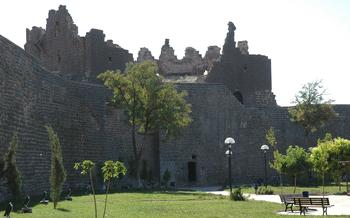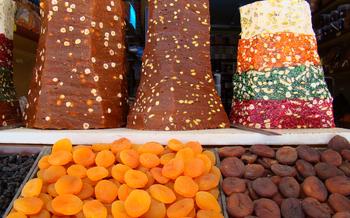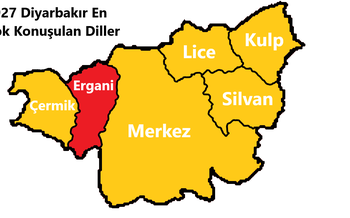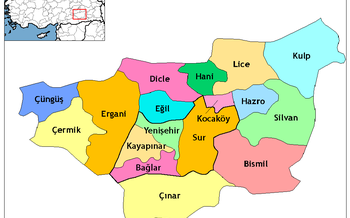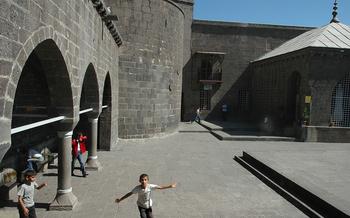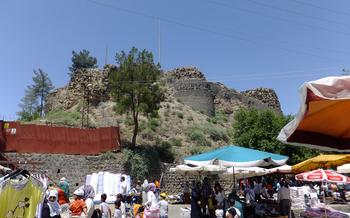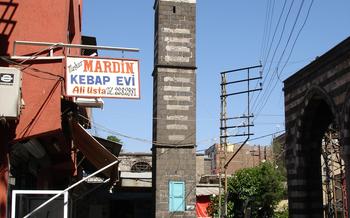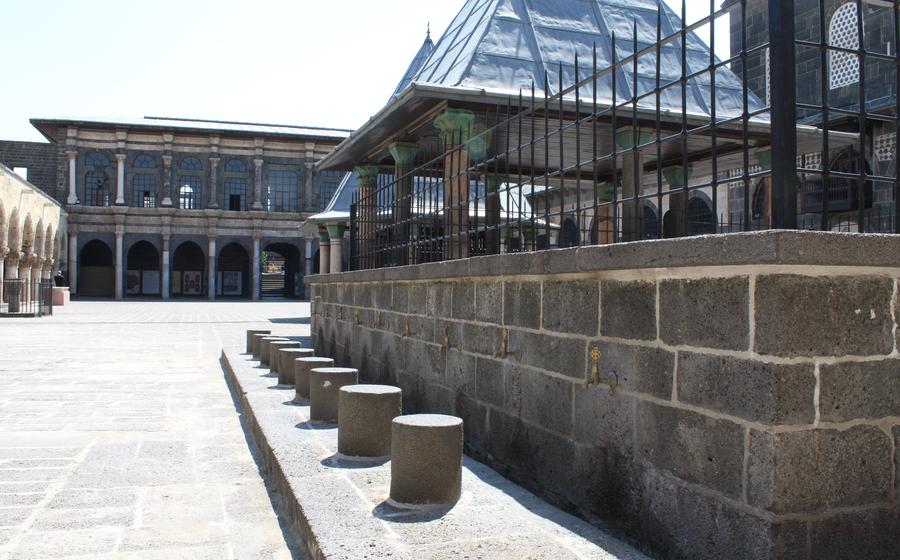
Sheikh Matar Mosque with its Four legged Minaret
- Atop the Hill: Sheikh Matar Mosque's Commanding Presence
- Standing Tall: The Unique Four-legged Minaret
- Historical Context and Architectural Significance
- Comparison with Other Minarets in Turkey
- Symbolism and Cultural Importance
- A Journey Through Time: The Mosque's Rich History
- Architectural Marvel: Exploring the Mosque's Design
- Sacred Spaces: The Prayer Hall and Mihrab
- A Place of Reflection: The Courtyard and Gardens
- A Bridge to the Past: The Sheikh Matar Tomb
- Taste of Diyarbakır: Local Cuisine near the Mosque
- Explore Diyarbakır: Beyond the Mosque
- When to Visit: The Best Time to Experience the Mosque
- Getting There: Transportation Options to the Mosque
- Hours of Operation and Admission Fees
- Guided Tours: Exploring the Mosque with an Expert
- Insider Tip: Unveiling Hidden Gems
Atop the Hill: Sheikh Matar Mosque's Commanding Presence
Perched atop a hill overlooking the historic city of Diyarbakır, the Sheikh Matar Mosque stands as a testament to the region's rich architectural heritage and religious devotion. Built in the 16th century during the reign of the Artuqid dynasty, the mosque boasts a distinctive architectural style that blends Islamic and Anatolian influences. Its prominent position on the hilltop offers visitors breathtaking panoramic views of the city, making it a must-see destination for anyone exploring Diyarbakır.
The Sheikh Matar Mosque holds immense symbolic significance for the people of Diyarbakır. Named after the revered Sufi saint and scholar Sheikh Matar, the mosque is considered a sacred site and a place of pilgrimage for many. Its towering presence serves as a reminder of the city's deep-rooted spiritual traditions and the enduring legacy of its past rulers.
Beyond its religious significance, the Sheikh Matar Mosque is also a testament to the architectural prowess of the Artuqid dynasty. The mosque's elegant design features intricate stone carvings, graceful arches, and a majestic dome that dominates the city's skyline. The harmonious blend of Islamic and Anatolian architectural elements creates a unique and visually stunning masterpiece that captivates visitors from around the world.
As you stand in the courtyard of the Sheikh Matar Mosque, the breathtaking views of Diyarbakır will leave you in awe. The city's ancient walls, bustling streets, and historic landmarks unfold before your eyes, creating a panoramic tapestry of urban beauty. Whether you're a history buff, an architecture enthusiast, or simply a traveler seeking a spiritual experience, the Sheikh Matar Mosque is a must-visit destination that promises to captivate and inspire.
Standing Tall: The Unique Four-legged Minaret
The Sheikh Matar Mosque's most distinctive feature is its four-legged minaret, a unique architectural element that sets it apart from other mosques in Turkey. The minaret, which stands tall at the corner of the mosque, is supported by four massive stone pillars that give it the appearance of a sturdy tower.
Historical Context and Architectural Significance
The four-legged minaret is a testament to the creativity and ingenuity of the Artuqid dynasty, who ruled Diyarbakır during the 11th and 12th centuries. This architectural style was a departure from the traditional round or octagonal minarets commonly found in Islamic architecture. The four-legged design provided additional support and stability to the minaret, allowing it to withstand the test of time and natural disasters.
Comparison with Other Minarets in Turkey
While four-legged minarets are relatively rare in Turkey, there are a few other examples that can be found in different parts of the country. One notable example is the Great Mosque of Diyarbakır, which also features a four-legged minaret. However, the Sheikh Matar Mosque's minaret is unique in its design and proportions, making it a standout among its counterparts.
Symbolism and Cultural Importance
The four-legged minaret holds significant symbolic meaning for the people of Diyarbakır. It represents the strength, resilience, and determination of the city's inhabitants. The minaret's unique design has become an iconic symbol of Diyarbakır, and it is often featured in local art, literature, and folklore.
The Sheikh Matar Mosque's four-legged minaret is a remarkable example of Islamic architecture and a testament to the rich cultural heritage of Diyarbakır. Its unique design and historical significance make it a must-see attraction for visitors to the city.
A Journey Through Time: The Mosque's Rich History
The Sheikh Matar Mosque stands as a testament to the rich history and cultural heritage of Diyarbakır. Its construction dates back to the Artuqid dynasty, which ruled the region during the 12th and 13th centuries. The mosque's initial construction was a testament to the architectural prowess of the Artuqids, who were renowned for their contributions to Islamic architecture.
Over the centuries, the mosque has undergone several renovations and additions, reflecting the changing political and cultural landscape of the region. In the 16th century, during the Ottoman period, the mosque was expanded and embellished with new decorative elements, including intricate tilework and calligraphy. These additions blended seamlessly with the original Artuqid architecture, creating a harmonious synthesis of styles.
The Sheikh Matar Mosque has served as a vibrant center of religious and community life throughout its history. It has been a place of worship, learning, and social gathering for the people of Diyarbakır. The mosque has also played a significant role in shaping the city's cultural identity, serving as a symbol of its rich heritage and resilience.
Numerous historical events and stories are associated with the Sheikh Matar Mosque. It is said that the mosque was a refuge for scholars and artisans during times of conflict, and its courtyard was used for public gatherings and celebrations. The mosque has also been the site of important religious ceremonies and festivals, bringing together people from all walks of life to celebrate their shared faith and culture.
Exploring the Sheikh Matar Mosque is like embarking on a journey through time, where visitors can witness the layers of history that have shaped this sacred space. The mosque's architecture, its rich symbolism, and its enduring legacy make it a must-see destination for anyone interested in understanding the cultural tapestry of Diyarbakır.
Architectural Marvel: Exploring the Mosque's Design
The Sheikh Matar Mosque showcases an architectural style that is both elegant and awe-inspiring. Its overall layout is based on a rectangular plan, with the entrance leading into a spacious prayer hall. The prayer hall is supported by massive columns, creating a sense of height and grandeur.
The mosque's dome is one of its most striking features. Constructed using traditional techniques, the dome is adorned with intricate patterns and motifs, which cast a beautiful play of light and shadow on the interior. The dome is supported by four squinches, which help distribute the weight of the structure.
Arches are another essential element of the mosque's design. They are found in the entrance, the windows, and the mihrab niche. The arches are both decorative and functional, contributing to the mosque's overall stability and beauty.
In addition to these structural elements, the mosque is embellished with various decorative features. The walls are adorned with colorful tiles, while the mihrab is decorated with intricate carvings and calligraphy. The overall effect is one of harmony and balance, creating a serene and uplifting atmosphere for prayer and contemplation.
Sacred Spaces: The Prayer Hall and Mihrab
The prayer hall of the Sheikh Matar Mosque exudes an atmosphere of awe and tranquility, inviting the faithful to immerse themselves in spiritual devotion. The vast space is adorned with intricate designs and elegant calligraphy, creating a harmonious and inspiring environment for congregational prayers. The mihrab, the focal point of the prayer hall, stands out as a masterpiece of Islamic architecture. Its intricate carvings and colorful tiles depict verses from the Quran, guiding the worshippers' focus towards Mecca. The acoustics of the prayer hall are carefully designed to amplify the voices of the imam and the congregation, creating a sense of unity and connection among the worshippers. During congregational prayers, the atmosphere in the prayer hall is electrifying, as the faithful raise their voices in unison, filling the space with a symphony of devotion and spirituality.
A Place of Reflection: The Courtyard and Gardens
The courtyard of the Sheikh Matar Mosque offers a serene and tranquil setting for contemplation and relaxation. Well-manicured gardens and landscaping create a beautiful and peaceful environment, enhanced by the soothing sounds of water features. Visitors can stroll through the gardens, admire the colorful flowers and lush greenery, and find a quiet spot to sit and reflect. The courtyard is a popular place for locals to gather and socialize, and it also hosts various events and activities throughout the year. It is a perfect place to escape the hustle and bustle of the city and find a moment of peace and tranquility.
A Bridge to the Past: The Sheikh Matar Tomb
Nestled within the tranquil confines of the Sheikh Matar Mosque complex lies a sacred space that emanates a profound sense of history and reverence—the Sheikh Matar Tomb. This revered site serves as the final resting place of Sheikh Matar, a figure deeply revered for his contributions to Diyarbakır's spiritual and intellectual landscape.
The tomb's architectural design mirrors the mosque's overall aesthetic, blending harmoniously with its surroundings. Its intricate carvings and decorative elements pay homage to the artistry and craftsmanship of its era. Visitors are captivated by the tomb's serene atmosphere, inviting them to pause and reflect on the life and legacy of Sheikh Matar.
According to local legends, Sheikh Matar was a pious scholar and a respected community leader who dedicated his life to spreading knowledge and promoting religious harmony. His teachings and guidance left an enduring impact on the people of Diyarbakır, earning him immense love and admiration.
Over time, the tomb evolved into a significant pilgrimage site for devotees seeking blessings and spiritual guidance. Many visitors come to pay their respects, offer prayers, and seek solace within the tomb's sacred space. The tradition of visiting the tomb has been passed down through generations, solidifying its importance as a bridge connecting the past with the present.
Taste of Diyarbakır: Local Cuisine near the Mosque
A visit to the Sheikh Matar Mosque is not complete without savoring the culinary delights of Diyarbakır. The city's cuisine is a vibrant blend of Turkish, Kurdish, and Arabic influences, offering a diverse range of flavors and aromas.
For a truly authentic experience, head to the small eateries and kebab houses nestled in the narrow streets surrounding the mosque. Here, you'll find locals indulging in hearty meals of freshly grilled meats, savory stews, and traditional flatbreads.
Must-try dishes include the iconic mırra, a spicy lamb stew cooked in a clay pot, and çiğ köfte, a raw meatball dish bursting with herbs and spices. Don't miss the Diyarbakır kebab, a succulent skewer of grilled lamb served with rice and grilled vegetables.
For a sweet treat, indulge in kabak tatlısı, a heavenly dessert made from shredded pumpkin simmered in syrup, or kadayıf dolması, a crispy pastry filled with chopped walnuts and sweetened cream.
Local restaurants often offer set menus that allow you to sample a variety of dishes at an affordable price. Be sure to try the meze platters, which feature an assortment of small appetizers such as hummus, baba ghanoush, and yaprak sarma (stuffed vine leaves).
When it comes to beverages, ayran, a refreshing yogurt drink, is a popular accompaniment to meals. Coffee lovers can enjoy a strong cup of Turkish coffee, prepared using the traditional method of boiling finely ground coffee in a cezve (copper pot).
With its rich and diverse culinary offerings, Diyarbakır is a paradise for food lovers. So, after exploring the Sheikh Matar Mosque, take some time to savor the delicious flavors of this vibrant city.
Explore Diyarbakır: Beyond the Mosque
Diyarbakır is a treasure trove of historical and cultural wonders, and there's much to explore beyond the Sheikh Matar Mosque. Embark on a walking tour to discover the majestic Diyarbakır Fortress, a UNESCO World Heritage site that has stood tall for centuries. Admire its imposing walls, explore its hidden chambers, and soak in the panoramic views from its ramparts.
Visit the Great Mosque of Diyarbakır, another architectural masterpiece with a rich history. Marvel at its intricate carvings, stunning courtyard, and unique minaret. Don't miss the iconic İçkale, the ancient heart of Diyarbakır, with its narrow cobbled streets, traditional houses, and bustling markets.
Explore the Haseki Museum, housed in a former palace, which showcases a fascinating collection of artifacts and exhibits that tell the story of Diyarbakır's past. Immerse yourself in the vibrant local culture at the Diyarbakır State Theater, where you can catch performances of traditional Kurdish plays, music, and dance.
Venture to the nearby Dört Ayaklı Minare Park, a green oasis with stunning views of the city and the mosque. Relax amidst the lush gardens, enjoy a picnic, and capture some breathtaking photos. Make sure to sample the delectable local cuisine at one of the many restaurants in the city, savoring the flavors of traditional dishes like mumbar dolması, ciğer kebabı, and the famous Diyarbakır karpuz.
Diyarbakır offers a wealth of experiences for every traveler. Whether you're a history buff, a culture enthusiast, or simply seeking a unique adventure, this city has something to offer.
When to Visit: The Best Time to Experience the Mosque
Diyarbakır's welcoming arms are open throughout the year, but the best time to visit the Sheikh Matar Mosque and explore the city is during the shoulder seasons of spring (April-May) and autumn (September-October). These months offer pleasant weather, with warm days and cool nights, ideal for outdoor exploration and sightseeing. The crowds are also smaller compared to the peak summer season, ensuring a more tranquil and immersive experience.
If you're seeking a vibrant and lively atmosphere, plan your visit during the annual Diyarbakır Culture and Art Festival, typically held in June. This festival showcases the city's rich cultural heritage through music, dance, art exhibitions, and traditional performances, providing a unique opportunity to immerse yourself in the local customs and traditions.
To avoid the scorching summer heat, it's advisable to steer clear of visiting Diyarbakır between July and August. Alternatively, if you're keen on experiencing the city's snowy landscapes, the winter months (December-February) offer a magical charm, although be prepared for colder temperatures and potential disruptions due to snowfall.
Remember that during the holy month of Ramadan, which falls on different dates each year, the mosque may have altered visiting hours or restrictions. It's always a thoughtful gesture to be respectful of local customs and traditions during this time.
Getting There: Transportation Options to the Mosque
Convenience at Your Fingertips: Public Transportation
The Sheikh Matar Mosque is conveniently accessible via public transportation. Multiple bus routes stop within walking distance of the mosque, providing a hassle-free and affordable option for visitors. Simply hop on a bus heading towards the city center and ask the driver or a fellow passenger to indicate the nearest stop to the mosque.
Taxis and Ride-sharing Services: A Swift and Comfortable Journey
For those seeking a more direct and comfortable journey, taxis and ride-sharing services are readily available in Diyarbakır. These services offer a convenient door-to-door experience, allowing visitors to arrive at the mosque without the hassle of navigation or parking. Simply hail a taxi on the street or use a ride-sharing app to request a ride.
Accessible Transportation for All
Visitors with limited mobility or those traveling with young children can opt for accessible transportation options. Wheelchair-accessible taxis and ride-sharing services are available upon request, ensuring a smooth and comfortable journey to the mosque.
Parking for Private Vehicles
For those arriving by private vehicle, several parking options are available in the vicinity of the mosque. Public parking lots and street parking are available within a short walking distance. Please be mindful of parking regulations and any fees associated with parking in designated areas.
Hours of Operation and Admission Fees
The Sheikh Matar Mosque welcomes visitors daily, offering free admission to all. Its doors are open from sunrise to sunset, allowing ample time to explore the mosque's architectural marvels and soak in its spiritual atmosphere. However, it's always advisable to plan your visit during daylight hours to fully appreciate the beauty of the mosque and its surroundings.
While there are no entrance fees, donations are gratefully accepted and contribute to the mosque's upkeep and preservation efforts. It's a thoughtful gesture to show your support for this historic landmark and ensure its continued maintenance for future generations.
Remember to dress respectfully when visiting the mosque. Modest attire that covers your shoulders and knees is recommended, reflecting the cultural norms and religious significance of the site. This dress code applies to both men and women, fostering an environment of mutual respect.
Photography is permitted within the mosque, but it's essential to be mindful of the sacred nature of the space. Avoid using flash photography and disturbing worshippers during prayer times. Instead, capture the mosque's grandeur with your eyes and heart, preserving the memories of your visit through respectful observation.
Guided Tours: Exploring the Mosque with an Expert
For a truly immersive and educational experience, consider joining a guided tour of the Sheikh Matar Mosque. Knowledgeable guides, often fluent in multiple languages, lead these tours, offering insights into the mosque's history, architecture, and cultural significance. They can point out intricate details and hidden gems that you might miss on your own, providing a deeper understanding of this remarkable landmark.
Guided tours can be arranged through local tour operators or directly at the mosque's visitor center. Prices vary depending on the duration and size of the group. Be sure to inquire about availability and book your tour in advance, especially during peak tourist season.
With a knowledgeable guide by your side, you'll gain a profound appreciation for the Sheikh Matar Mosque's architectural wonders, rich history, and enduring legacy. Whether you're a history buff, an architecture enthusiast, or simply seeking a deeper connection with Diyarbakır's culture, a guided tour is an excellent way to unlock the secrets of this extraordinary mosque.
Insider Tip: Unveiling Hidden Gems
-
Secret Spot for a Unique Perspective: Venture to the rooftop terrace of the mosque's minaret for a breathtaking panorama of Diyarbakır. Capture stunning cityscapes and enjoy a unique perspective of the mosque's grandeur from above.
-
Panoramic Viewpoint: Discover the hidden viewpoint atop the hill behind the mosque. This secluded spot offers uninterrupted vistas of the city, allowing you to soak in the beauty of Diyarbakır's skyline.
-
Authentic Culinary Experience: Step into the culinary haven of [Restaurant Name], nestled in a charming alleyway near the mosque. Savor authentic Diyarbakır cuisine, prepared with fresh local ingredients and traditional recipes passed down through generations.
-
Off-the-Beaten-Path Attraction: Explore the ancient [Historical Site Name], located a short walk from the mosque. This hidden gem boasts well-preserved ruins, intricate carvings, and a fascinating history waiting to be unearthed.
